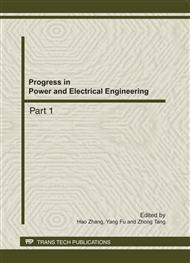p.989
p.993
p.998
p.1002
p.1007
p.1012
p.1016
p.1022
p.1027
Research on the Generation Expansion Planning in Carbon Market in China
Abstract:
The model of GEP in carbon market is established by introducing the carbon economy index proposed in this paper to traditional GEP model. Considering the operation experience of European Union Emission Trading System (EU ETS), the proposed index mainly consists of the CO2 emission load and the carbon price, which works as two forms in the established model: the carbon income in objective function and the CO2 reduction constraint in constraints. Especially, this paper divides the CO2 reduction constraint into two parts working in different planning period, so as to provide the flexibility and the result control for the planning. And the simulation shows that the GEP in the carbon market can guide the power structure adjustment and reduce CO2 emissions.
Info:
Periodical:
Pages:
1007-1011
Citation:
Online since:
October 2011
Authors:
Price:
Сopyright:
© 2012 Trans Tech Publications Ltd. All Rights Reserved
Share:
Citation:


